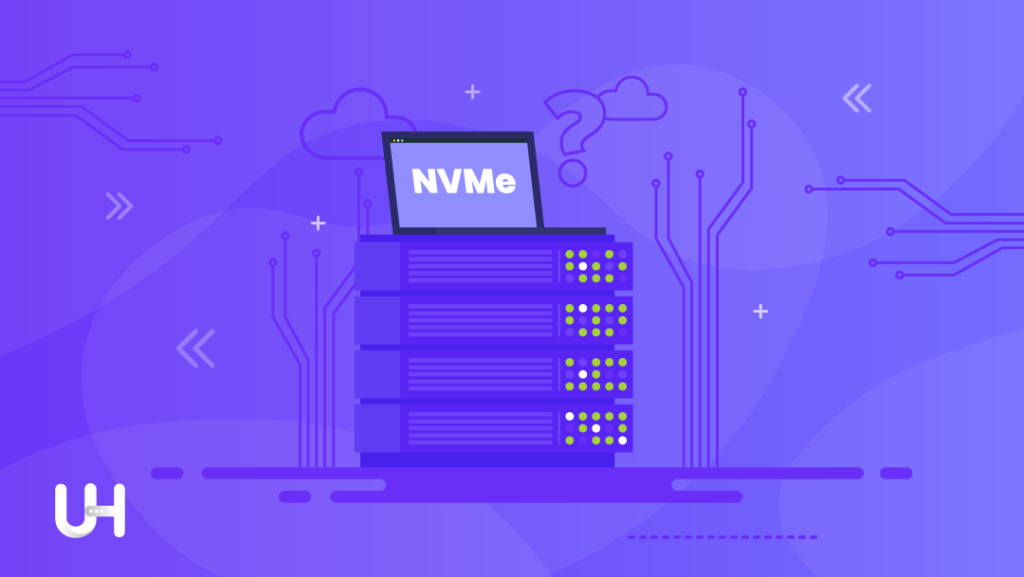Solid State Drives (SSDs) have replaced traditional Hard Disk Drives (HDDs) as the preferred storage solution in modern computing. SSDs offer faster data access, improved reliability, energy efficiency, and silent operation due to their lack of moving parts.
In this blog, we’ll discuss Solid State Drive technology, types, benefits, and how to choose the right SSD for your needs. By the end, you’ll be able to make informed decisions when incorporating SSDs into your computing setup.
What is an SSD?
An SSD, or Solid State Drive, is a type of storage device that stores data using integrated circuit assemblies as memory. Unlike traditional Hard Disk Drives (HDDs) that use spinning disks and mechanical arms to read and write data, SSDs have no moving parts. This absence of mechanical components allows SSDs to access data faster and more reliably than HDDs. Moreover, makes it the best storage type for your web server.
Basic Components and Structure
SSDs consist of several key components:
- NAND flash memory chips: These memory chips are the primary storage medium in SSDs. They consist of floating-gate transistors that retain data even when the power is turned off. NAND flash memory is organized into pages and blocks, with each block containing multiple pages.
- Controller: The controller serves as the central processing unit, managing data storage and retrieval operations. It communicates with the host system, regulates data flow between the NAND flash memory and the host, and performs tasks such as wear-leveling, garbage collection, and error correction to ensure data integrity and maximize SSD lifespan.
- Cache: Some Solid State Drives feature a cache, which is a small amount of high-speed memory used to temporarily store frequently accessed data. The cache helps improve overall SSD performance by reducing access times for commonly accessed data.
How SSDs Work?
Solid-State Drives (SSDs) have become the go-to choice for storage solutions across various computing devices, from laptops to dedicated servers. Their popularity stems from their remarkable speed, reliability, and efficiency, all of which are made possible by their unique architecture and data storage mechanisms. To understand how SSDs work, let’s delve into their internal components and operational processes in detail.
NAND Flash Memory
At the core of every SSD are NAND flash memory chips. These chips consist of numerous memory cells arranged in a grid-like fashion. Each cell can store a certain amount of data by trapping electrical charges within its semiconductor material. The presence or absence of these charges represents binary data (0s and 1s), enabling the storage of digital information.
NAND flash memory is classified into different types based on its structure and operation, such as Single-Level Cell (SLC), Multi-Level Cell (MLC), Triple-Level Cell (TLC), and Quad-Level Cell (QLC). These classifications determine factors like storage density, performance, and cost, with SLC offering the highest performance but lowest storage density, and QLC providing the highest density but lower performance.
Controller
The controller is the central processing unit of an SSD, responsible for managing the storage and retrieval of data. It communicates with the host device (e.g., computer, server) and orchestrates the flow of data between the host and the NAND flash memory chips.
Key functions of the SSD controller include:
- Data Encoding and Decoding: The controller converts data received from the host into a format suitable for storage in the NAND flash memory, and vice versa.
- Wear-Leveling: NAND flash memory cells have a limited lifespan, characterized by a finite number of program/erase cycles. To prevent premature wear-out of individual cells, the controller evenly distributes write operations across the memory cells, ensuring uniform usage and extending the overall lifespan of the Solid State Drive.
- Error Correction: SSDs employ error correction algorithms to detect and correct data errors that may occur during storage or transmission, enhancing data integrity and reliability.
- Garbage Collection: As data is written, deleted, and modified on an SSD, unused memory blocks accumulate remnants of old data. The controller performs garbage collection, identifying and consolidating these unused blocks to free up space for new data and maintain optimal performance.
Data Storage and Retrieval
When data is written to Solid State Drive, the controller coordinates the process of programming the NAND flash memory cells with the appropriate electrical charges. This process involves applying voltage to the memory cells to store data as electrical charges, with the presence or absence of charges representing binary values.
During data retrieval, the controller reads the electrical charges stored in the memory cells and converts them back into digital information, which is then transmitted to the host device.
Overall, the seamless interaction between NAND flash memory, the controller, and various algorithms and processes enables SSDs to deliver exceptional performance, reliability, and efficiency, making them indispensable components of modern computing systems.
Types of SSDs
Solid-State Drives (SSDs) have evolved to encompass various types, catering to a wide range of needs and preferences in terms of performance, form factor, and application requirements. Understanding the distinctions between these SSD types can assist users in making informed decisions when selecting the most appropriate option for their specific use case. Let’s explore in detail the different types of SSD drives available in the market:
SATA SSDs
SATA (Serial Advanced Technology Attachment) SSDs are among the most prevalent types of SSDs, particularly in consumer-grade computing devices. These SSDs utilize the SATA interface, a standard connection interface that is widely supported by motherboards and storage controllers. SATA SSDs offer a significant performance improvement over traditional hard disk drives (HDDs) while maintaining backward compatibility with existing systems.
- Interface: SATA III (6 Gbps)
- Form Factor: 2.5-inch (standard size for desktops and laptops)
- Performance: SATA SSDs typically offer sequential read and write speeds of up to 550/520 MB/s, respectively, providing a noticeable boost in system responsiveness.
- Applications: Commonly used in consumer desktops, laptops, and entry-level servers due to their balance of performance, affordability, and compatibility.
NVMe SSDs
NVMe (Non-Volatile Memory Express) SSDs represent a significant leap forward in storage technology, designed to leverage the high-speed PCIe (Peripheral Component Interconnect Express) interface for maximum performance. Unlike SATA SSDs, which communicate through the relatively slower SATA interface, NVMe storage establishes a direct connection with the CPU via PCIe lanes, resulting in significantly faster data transfer rates and reduced latency.
- Interface: PCIe Gen3 x4 or PCIe Gen4 x4
- Form Factor: NVMe SSDs are available in various form factors, including M.2 and add-in card (AIC), offering flexibility in deployment.
- Performance: NVMe SSDs can achieve sequential read and write speeds exceeding 3000/2000 MB/s, respectively, delivering blazing-fast performance ideal for demanding workloads such as high-performance computing, gaming, content creation, and data-intensive applications.
- Applications: NVMe Solid State Drives are commonly used in high-performance computing systems, gaming PCs, workstations, and applications requiring rapid data access and processing.
Upgrade Your Storage Today!
Experience blazing-fast speeds with NVMe SSDs. Explore our range of NVMe VPS solutions for unrivaled performance. Don’t miss out!
M.2 SSDs
M.2 SSDs represent a compact and versatile form factor, offering storage solutions in a smaller footprint compared to traditional 2.5-inch SATA SSDs. These Solid State Drives are available in both SATA and NVMe variants, making them suitable for a wide range of devices, from ultra-thin laptops to small form factor desktops.
- Interface: M.2 Solid State Drives can utilize either the SATA III or PCIe Gen3 x4 interface, providing options for different performance requirements.
- Form Factor: M.2 Solid State Drives are characterized by their slim and small form factor, making them suitable for integration into space-constrained devices such as ultrabooks, tablets, mini PCs, and embedded systems.
- Performance: Performance varies depending on the interface used, with NVMe M.2 SSDs offering higher speeds compared to SATA.
- Applications: M.2 SSDs are commonly used in thin and light laptops, mini PCs, gaming consoles, and other compact computing devices where space is limited, and performance is crucial.
Enterprise SSDs
Enterprise SSDs are specifically engineered for use in data centers, servers, and enterprise-grade storage systems with enterprise hosting, where reliability, endurance, and performance consistency are paramount. These Solid State Drives are optimized to meet the demanding requirements of high-availability environments and mission-critical workloads.
- Interface: Enterprise SSDs may utilize SATA, SAS (Serial Attached SCSI), or NVMe interfaces, depending on the specific use case and deployment scenario.
- Form Factor: Enterprise SSDs are available in various form factors, including 2.5-inch, U.2, and EDSFF (Enterprise and Data Center Form Factor), catering to different server and storage system configurations.
- Performance: Solid State Drives offer high throughput and IOPS (Input/Output Operations Per Second), ensuring rapid data access and processing for data-intensive applications.
- Features: Enterprise SSDs often incorporate features such as power loss protection, advanced error correction, end-to-end data protection, and data integrity mechanisms to ensure the reliability and integrity of stored data.
- Applications: Enterprise Solid State Drives are deployed in data center storage arrays, cloud computing infrastructure, virtualized environments, and enterprise applications requiring high-performance storage solutions.
Choosing the right type of SSD depends on various factors, including performance requirements, compatibility with existing hardware, form factor constraints, and budget considerations. Whether for personal computing, gaming, or enterprise storage, there is an SSD type suited to every need, offering a balance of performance, reliability, and efficiency.
Benefits of SSDs
Speed
Solid State Drives offer unparalleled speed compared to traditional Hard Disk Drives (HDDs). While HDDs rely on mechanical components such as spinning platters and read/write heads to access data, SSDs utilize NAND flash memory, allowing for much faster data access. The absence of moving parts in SSDs enables almost instantaneous data retrieval, leading to significantly reduced loading times for applications and faster boot times for operating systems.
Impact on system performance:
The speed advantage of Solid State Drives translates into a noticeable improvement in overall system performance. Tasks that involve reading or writing large amounts of data, such as launching applications, loading games, or transferring files, are completed much faster with an SSD. This results in a smoother and more responsive user experience, especially in demanding computing environments where speed is crucial.
Reliability
One of the most significant advantages of SSDs is their lack of moving parts. Unlike HDDs, which are prone to mechanical failures due to the constant spinning of disks and movement of read/write heads, SSDs have no such components. This inherent reliability gives data security on your storage server and makes SSDs less susceptible to mechanical failures, such as head crashes or motor failures, resulting in improved data integrity and reduced risk of drive failure.
Reduced risk of mechanical failures:
Because SSDs do not rely on mechanical components to read and write data, they are inherently more reliable than HDDs. Mechanical failures, such as head crashes or motor failures, are common issues with HDDs but are virtually nonexistent in SSDs. This increased reliability makes Solid State Drives an ideal choice for critical applications where data integrity and system uptime are paramount.
Durability
SSDs are highly durable and resistant to physical shock and vibration. Unlike HDDs, which can be damaged if subjected to sudden impacts or movement, Solid State Drives can withstand harsh operating conditions without compromising data integrity. This durability makes SSDs suitable for use in portable devices such as laptops and tablets, where they may be exposed to rough handling or transportation.
Suitable for portable devices:
The durability and compact form factor of SSDs make them ideal for use in portable devices. SSDs consume less space and are lighter than HDDs, making them well-suited for slim laptops, ultrabooks, and other portable computing devices. Additionally, the absence of moving parts in SSDs reduces the risk of damage during transportation, ensuring data safety and reliability on the go.
Energy efficiency
SSDs consume significantly less power than HDDs, resulting in lower energy consumption and extended battery life in laptops and other battery-powered devices. Since SSDs do not have any moving parts that require power to operate, they use less energy during both active and idle states, leading to reduced heat generation and improved energy efficiency.
Environmental benefits:
The energy efficiency of SSDs not only benefits users by prolonging battery life but also has environmental benefits by reducing overall power consumption and carbon emissions. By choosing SSDs over HDDs, users can contribute to energy conservation efforts and reduce their carbon footprint, making Solid State Drives a more environmentally friendly storage solution.
Noiseless operation
SSDs operate silently due to their lack of mechanical components. Unlike HDDs, which produce noise from spinning disks and moving parts, SSDs are completely silent during operation, providing a quieter computing environment and minimizing distractions for users.
Improved user experience:
The noiseless operation of SSDs enhances the user experience by eliminating the distracting noise generated by traditional HDDs. Whether it’s working in a quiet office environment or enjoying multimedia content at home, users can benefit from the silent operation of SSDs, resulting in a more comfortable and enjoyable computing experience.
Applications of SSDs

Solid-State Drives (SSDs) have transformed the landscape of storage solutions, offering unmatched speed, reliability, and efficiency compared to traditional Hard Disk Drives (HDDs). The versatility and performance of Solid State Drives make them indispensable across a broad spectrum of computing environments. Let’s explore in detail the diverse applications of SSDs:
Personal Computing
Solid State Drives have become standard components in personal computing devices, including desktops, laptops, and ultrabooks. In personal computing, Solid State Drives delivers significant performance improvements over HDDs, resulting in faster boot times, quicker application loading, and overall snappier system responsiveness. Users benefit from the seamless multitasking capabilities and smoother user experience provided by SSDs, enhancing productivity and enjoyment of everyday computing tasks such as web browsing, multimedia consumption, and productivity applications.
Gaming
SSDs are a game-changer in the gaming industry, where speed and responsiveness are paramount for delivering immersive gaming experiences. Solid State Drives dramatically reduce load times in games, enabling faster level loading, smoother gameplay, and quicker transitions between game scenes. Gaming enthusiasts and professionals rely on NVMe storage for game VPS hosting to minimize stuttering, eliminate texture pop-in, and reduce input lag, resulting in a more fluid and enjoyable gaming experience. Additionally, SSDs enhance the performance of gaming consoles, ensuring faster game installations, updates, and patch downloads.
Content Creation
Content creators, including video editors, graphic designers, and multimedia professionals, leverage the power of Solid State Drives to accelerate their workflow efficiency and productivity. SSDs enable faster access to large multimedia files, facilitating quicker rendering, editing, and processing of videos, images, and other content. Content creators benefit from the high-speed data transfer rates of Solid State Drives, which ensure smooth playback and editing of high-resolution media files, enhancing creativity and reducing downtime. SSDs also enable seamless collaboration and sharing of content among team members, improving collaboration and project management.
Enterprise and Data Center
Solid State Drives play a vital role in enterprise and data center environments. Here performance, reliability, and scalability are essential for handling mission-critical workloads and managing massive amounts of data. Solid State Drives are deployed in storage arrays, servers, and virtualized environments. It is to support demanding applications such as database management, online transaction processing (OLTP), data analytics, and cloud computing. Enterprise-grade SSDs offer high throughput and low latency. Moreover, advanced features such as power loss protection, data encryption, end-to-end data integrity. It ensures the integrity and availability of stored data.
Embedded Systems
SSDs are integrated into a wide range of embedded systems and specialized devices. It includes industrial automation equipment, automotive infotainment systems, medical devices, and IoT (Internet of Things) devices. In embedded applications, Solid State Drives provide reliable and durable storage solutions capable of withstanding harsh operating conditions, temperature fluctuations, and vibration. Solid State Drives enable fast boot times, quick data access, and efficient operation in resource-constrained embedded systems. Furthermore, enhancing the performance and functionality of these devices.
In short, the versatility, performance, and reliability of Solid State Drives make them indispensable across various computing environments. As SSD technology continues to advance, the range of applications and benefits will expand, driving further adoption and innovation in the storage industry.
Considerations for Choosing an SSD
Selecting the right Solid-State Drive (SSD) involves assessing various factors to ensure compatibility, performance, and value for your specific needs. Whether you’re upgrading an existing system or building a new one, considering the following factors can help you make an informed decision when choosing a Solid State Drive:
Capacity Requirements
Determining the appropriate capacity for your Solid State Drive is crucial to ensure you have enough storage space for your operating system, applications, games, and multimedia files. Assess your storage needs based on your usage patterns and the types of files you typically work with. Consider both your current requirements and any future expansion needs. Solid State Drive capacities range from a few hundred gigabytes to several terabytes, so choose a capacity that provides ample storage without overspending on excess storage you won’t use.
Performance Considerations
Performance is a critical factor in Solid State Drive selection, influencing system responsiveness, data transfer rates, and overall user experience. When evaluating performance, consider factors such as read and write speeds, random read/write performance, and endurance. Look for SSDs with high sequential and random read/write speeds to ensure fast data access and transfer rates. Consider the workload you’ll be subjecting the SSD storage to, whether it’s everyday computing tasks, gaming, content creation, or enterprise applications, and choose a model with adequate performance and endurance for your specific usage scenario.
Interface and Form Factor
Solid State Drives come in various interfaces and form factors, each offering different levels of performance, compatibility, and flexibility. The most common interfaces are SATA and NVMe, with SATA SSDs typically offering lower performance than NVMe SSDs. Additionally, consider the form factor of the SSD, such as 2.5-inch SATA SSDs, M.2 NVMe SSDs, or add-in card (AIC) NVMe SSDs. Ensure compatibility with your motherboard and system configuration by selecting an SSD with the appropriate interface and form factor.
Compatibility
Before purchasing a Solid State Drive, verify compatibility with your system’s hardware and software. It includes the motherboard, chipset, operating system, and firmware. Check for compatibility with SATA or PCIe slots. Moreover, with motherboard BIOS/UEFI support for NVMe and drivers or firmware updates required for optimal performance. Consult the SSD manufacturer’s specifications and compatibility lists to ensure seamless integration with your system. It is to avoid compatibility issues that could affect performance or functionality.
Endurance and Reliability
Assessing the endurance and reliability features of a Solid State Drive is essential. It ensures data integrity and long-term reliability, especially for applications with heavy workloads or mission-critical data. Look for SSDs with high endurance ratings. Typically expressed as Total Bytes Written (TBW), indicating the amount of data that can be written to the drive. Additionally, consider reliability features such as advanced error correction, wear-leveling algorithms, and power loss protection mechanisms. It will safeguard your data against errors, corruption, and data loss.
Budget Considerations
Establishing a budget for your Solid State Drive purchase is essential. It ensures you get the best value for your money without overspending on features or performance you don’t need. Compare prices across different SSD models and brands, considering factors such as capacity, performance, reliability features, and warranty coverage. Evaluate the price-to-performance ratio of each SSD to determine the best value proposition for your specific requirements and budget constraints.
By carefully considering these factors, you can make an informed decision when choosing a Solid State Drive. Moreover, it ensures that SSD meets your storage needs, performance expectations, and budget constraints. Whether you’re upgrading a personal computer, building a gaming rig, or deploying enterprise storage solutions, selecting the right SSD ensures optimal performance, reliability, and value for your specific use case.
Conclusion
In conclusion, Solid-State Drives (SSDs) stand as the pinnacle of storage innovation. It is redefining the computing experience with their unmatched speed, reliability, and efficiency compared to traditional Hard Disk Drives (HDDs).
SSDs offer a plethora of benefits, including faster boot times, seamless application loading, enhanced system responsiveness, and silent operation—all while boasting improved reliability, durability, and energy efficiency. Whether for personal use, gaming, content creation, or enterprise-level applications, Solid State Drives provide a performance boost that elevates computing experiences to new heights.
Whether you’re a gaming enthusiast, a content creator, or an enterprise seeking robust storage solutions, we have you covered. Elevate your storage experience today with Ultahost’s Storage VPS offerings.
FAQ
What is an SSD, and how is it different from an HDD?
An SSD (Solid-State Drive) uses flash memory for data storage, while an HDD (Hard Disk Drive) relies on spinning disks and mechanical parts. SSDs offer faster speeds, higher reliability, and lower power consumption.
What are the benefits of using an SSD?
SSDs provide faster boot times, quicker application loading, improved system responsiveness, reliability, durability, energy efficiency, and silent operation.
What factors should I consider when choosing an SSD?
Consider capacity, performance (read/write speeds, endurance), compatibility (interface, form factor), system compatibility, reliability features, and budget.
What types of SSDs are available, and how do they differ?
Types include SATA SSDs (standard), NVMe SSDs (faster), M.2 SSDs (compact), and Enterprise SSDs (optimized for data centers).
How do I maintain and optimize the performance of my SSD?
Keep firmware up to date, enable TRIM support, avoid filling to full capacity, minimize unnecessary read/write operations.











